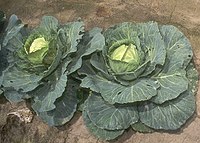
Photo from wikipedia
Summary Glutathione S-transferases (GST) belong to a super-family of multifunctional proteins and are one of the most important families of detoxifying enzymes in nature. There are involved in diverse intracellular… Click to show full abstract
Summary Glutathione S-transferases (GST) belong to a super-family of multifunctional proteins and are one of the most important families of detoxifying enzymes in nature. There are involved in diverse intracellular events such as, primary and secondary metabolisms, stress metabolism, herbicide detoxification and plant protection against ozone damages, heavy metals, xenobiotics and microbes infections as well as in various aspects of seedling development, including hypocotyl elongation, anthocyanin accumulation, and the like. The crucial functions of GSTs have stimulated the development of novel applications in analytical and agricultural biotechnology. In this last field, GSTs are exploited in the development of transgenic plants with increased resistance to biotic and abiotic stresses. Deepening on the study of GST functions will allow addressing new strategies to improve the yields of agronomic crops, not only in the face of threats of climate change, but also for the agriculture of the future.
Journal Title: Plant Gene
Year Published: 2020
Link to full text (if available)
Share on Social Media: Sign Up to like & get
recommendations!